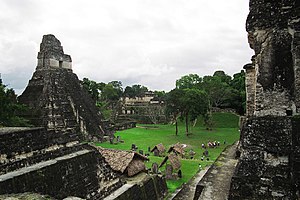
| This article is part of a series on the |
| Maya civilization |
|---|
 |
| History |
| Spanish conquest of the Maya |
|
|
Maya cities were the centres of population of the pre-Columbian Maya civilization of Mesoamerica. They served the specialised roles of administration, commerce, manufacturing and religion that characterised ancient cities worldwide.[1] Maya cities tended to be more dispersed than cities in other societies, even within Mesoamerica, as a result of adaptation to a lowland tropical environment that allowed food production amidst areas dedicated to other activities.[1] They lacked the grid plans of the highland cities of central Mexico, such as Teotihuacán and Tenochtitlan.[2] Maya kings ruled their kingdoms from palaces that were situated within the centre of their cities.[3] Cities tended to be located in places that controlled trade routes or that could supply essential products.[4] This allowed the elites that controlled trade to increase their wealth and status.[4] Such cities were able to construct temples for public ceremonies, thus attracting further inhabitants to the city.[4] Those cities that had favourable conditions for food production, combined with access to trade routes, were likely to develop into the capital cities of early Maya states.[4]
The political relationship between Classic Maya city-states has been likened to the relationships between city-states in Classical Greece and Renaissance Italy.[5] Some cities were linked to each other by straight limestone causeways, known as sacbeob, although whether the exact function of these roads was commercial, political or religious has not been determined.[6]
